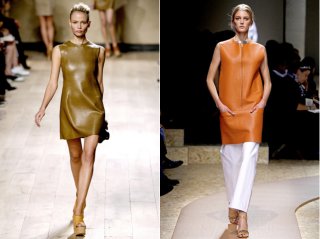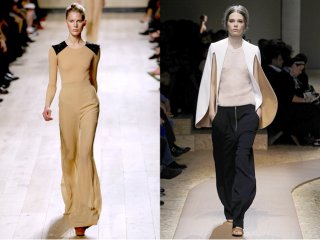Tentacl Ventricl
Member
- Joined
- Oct 13, 2009
- Messages
- 514
- Reaction score
- 1
I see it's still all going off and handbags at 30 paces in the Gimmethatbag, Uemarasan, Chloehandbags gender politics, free will - determinism dialogue. Just surrendering and calling it the wet dream discussion is admittedly less of a mouthful.
If we bring to the forefront of our minds the fact that Celine SS10 and AW10/11 has been a resounding commercial success story, there's something of a tautology in what you're saying here Mutterlein.
You seem to be agreeing that SS11 is relatively less sexy in comparison with SS10 but then denying that the sensuality of Phoebe's first two Celine collections was an integral part of their success. I'm sorry but I think most people would say that SS10 Celine was sexy. Tastefully so yes but sexy nevertheless. And clearly with that SS10 collection Phoebe did tap into what women want. It was commercially spot on, a buyer's wet dream. Quite simply - sex sells. [and as an aside to the gender politics dialogue do note that that is a gender neutral mantra]
View attachment 555801
View attachment 555803
edit - how infuriating that my attachments wont appear. I have mailed the administrator in attempt to fix it.
In figure 1 we see that for SS11 (right hand image) Phoebe's treatment of leather has become relatively less sculpted to the body. The weight looks heavier. It's a roomier, less sensual silhouette. Stiffer, more forbidding somehow. If this makes sense, SS11 is further removed from Versace, it's less bodycon. It's less commercial.
In figure 2 SS11 on the right shows more nipple but there's no question in my mind which image most people would find sexier. Again the SS10 is characterised by how bodycon it is. SS11 is altogether an easier, slouchier silhouette. SS10 is just that bit more luxe and uptown. By comparison it's a bit more Versace/Gucci, a bit more Milanese. It's more commercial. In SS10 Phoebe delivered perfectly 'what women want'. SS11 remains up for grabs on that score.
But Mutterlein it was really this part that got me thinking - As the creative director I highly doubt she would have sent anything down the runway she wasn't sure about.
It begs the question can a creative director at a PPR or LVMH brand always do exactly what they want. Prey tell those who are in the first hand know about such group politics, but I imagine the answer is no they can't. No, surely within such big congolmerates what the designer produces is directed to an extent by overall commercial strategy. It isn't just about the whim of Phoebe it's about brand positioning within group strategy. And so, I'm afraid Chloehandbags, it's two men in particular - Francois Pinault and Bernard Arnault - who are influential in discerning and delivering what women want. And if you're going to try to tell us those two don't know 'what women want' then think again.
It leaves the question what has gone on here for SS11 brand positioning at Celine. You take a winning formula then you break it? Off the back of a commercially successful collection you then deliver something very different, a collection which, on the face of it, is less obviously commercial, a bit more leftfield. I have a theory as to why but I'll break off and deliver that later as my posts can tend to get so long as to be impenetrable.
Oh - I'll just add here the thought about there being less bags on the SS11 Celine runway (I take it on trust that whoever noted less bags this season was right as I've not counted). We all know that PPR and LVMH are geared up to peddle leathergoods, eyewear and scent much moreso than garments. It's where margin and volume lies, where the mid market feels most comfortable about acquiring a slice of the brand. So is less bags on a runway to be read as a sign - a statement that this is intended as a less commercial offering, not so directly 'about' sales more about brand positioning and perception...
As the creative director I highly doubt she would have sent anything down the runway she wasn't sure about.
I agree, this collection is not as sexed up as some would like, perhaps that's what blocking them. But I would like to think Celine is for the modern woman that does not dress to be sexy, only for herself. Unfortunately that disqualifies most women. Oh well, their loss.
If we bring to the forefront of our minds the fact that Celine SS10 and AW10/11 has been a resounding commercial success story, there's something of a tautology in what you're saying here Mutterlein.
You seem to be agreeing that SS11 is relatively less sexy in comparison with SS10 but then denying that the sensuality of Phoebe's first two Celine collections was an integral part of their success. I'm sorry but I think most people would say that SS10 Celine was sexy. Tastefully so yes but sexy nevertheless. And clearly with that SS10 collection Phoebe did tap into what women want. It was commercially spot on, a buyer's wet dream. Quite simply - sex sells. [and as an aside to the gender politics dialogue do note that that is a gender neutral mantra]
View attachment 555801
View attachment 555803
edit - how infuriating that my attachments wont appear. I have mailed the administrator in attempt to fix it.
In figure 1 we see that for SS11 (right hand image) Phoebe's treatment of leather has become relatively less sculpted to the body. The weight looks heavier. It's a roomier, less sensual silhouette. Stiffer, more forbidding somehow. If this makes sense, SS11 is further removed from Versace, it's less bodycon. It's less commercial.
In figure 2 SS11 on the right shows more nipple but there's no question in my mind which image most people would find sexier. Again the SS10 is characterised by how bodycon it is. SS11 is altogether an easier, slouchier silhouette. SS10 is just that bit more luxe and uptown. By comparison it's a bit more Versace/Gucci, a bit more Milanese. It's more commercial. In SS10 Phoebe delivered perfectly 'what women want'. SS11 remains up for grabs on that score.
But Mutterlein it was really this part that got me thinking - As the creative director I highly doubt she would have sent anything down the runway she wasn't sure about.
It begs the question can a creative director at a PPR or LVMH brand always do exactly what they want. Prey tell those who are in the first hand know about such group politics, but I imagine the answer is no they can't. No, surely within such big congolmerates what the designer produces is directed to an extent by overall commercial strategy. It isn't just about the whim of Phoebe it's about brand positioning within group strategy. And so, I'm afraid Chloehandbags, it's two men in particular - Francois Pinault and Bernard Arnault - who are influential in discerning and delivering what women want. And if you're going to try to tell us those two don't know 'what women want' then think again.
It leaves the question what has gone on here for SS11 brand positioning at Celine. You take a winning formula then you break it? Off the back of a commercially successful collection you then deliver something very different, a collection which, on the face of it, is less obviously commercial, a bit more leftfield. I have a theory as to why but I'll break off and deliver that later as my posts can tend to get so long as to be impenetrable.
Oh - I'll just add here the thought about there being less bags on the SS11 Celine runway (I take it on trust that whoever noted less bags this season was right as I've not counted). We all know that PPR and LVMH are geared up to peddle leathergoods, eyewear and scent much moreso than garments. It's where margin and volume lies, where the mid market feels most comfortable about acquiring a slice of the brand. So is less bags on a runway to be read as a sign - a statement that this is intended as a less commercial offering, not so directly 'about' sales more about brand positioning and perception...
Last edited by a moderator:






